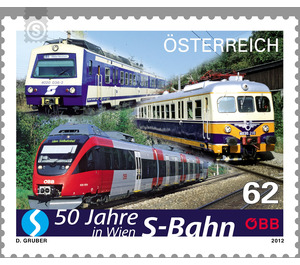150 years - Austria / II. Republic of Austria 2012 - 62 Euro Cent
Theme: Traffic, Transportation & Mobility
| Country | Austria / II. Republic of Austria |
| Issue Date | 2012 |
| Face Value | 62.00 |
| Edition Issued | 300,000 |
| Printing Type | offset |
| Stamp Type | Commemorative |
| Item Type | Stamp |
| Chronological Issue Number | 2311 |
| Chronological Chapter | OOS-OE2 |
| SID | 38738 |
| In 59 Wishlists | |
In addition to the services offered by Wiener Linien, it is the second component of the city's public transport system. Incidentally, the term "rapid-transit railway" in Vienna was for a long time uncommon, although it was occasionally used in literature even before 1962; From 1962 to 2005 almost exclusively the term "Schnellbahn" was used. It was not until the timetable change in 2005/2006 that the term "S-Bahn" was officially established in timetable signs and loudspeaker announcements. History: The opening of the Schnellbahn took place on 17 January 1962 - with celebrations in the presence of over 900 invited guests, headed by President Adolf Schärf and Vice Chancellor Bruno Pittermann. After the big ceremony at the South Station with speeches by ÖBB Director General Maximilian Schantl, Transport Minister Karl Waldbrunner, the Vienna Mayor Franz Jonas and Head of State Adolf Schärf, a pageant was put into operation, which stopped at each stop of the main line, where the respective district chiefs each short speeches held. Then the train went to Gänserndorf, where a class 52 locomotive was set up. Then the train returned to Floridsdorf and drove to Stockerau, where it was greeted by the local mayor. Then the routes were used without passengers. The actual passenger service started in the evening at 23.45. One thing is for certain: the Schnellbahn was a great success from the beginning. It came to overcrowding, which could be eliminated only by the use of double sets. An agreement was concluded with Wiener Verkehrsbetriebe which allowed passengers to use the parallel lines of the other mode of transport without additional ticket purchase in the event of a breakdown. In 1963, the first television monitors were installed on the Südbahnhof station on a trial basis. Initially, on the main line was still driven every fifteen minutes, but already in October of the opening year traffic between Floridsdorf and highway in the rush hour was compressed, from 1964 then on the entire trunk line. Following a steady expansion of the rail network in recent decades, current plans for expansion remain limited. Nevertheless: In the course of the construction of the new Vienna Main Station on the site of the former Südbahnhof, an environmental impact assessment is currently in progress for the connection of the Ostbahntrasse with the route of the Flughafenschnellbahn to reach an optimal connection to the Vienna International Airport.


